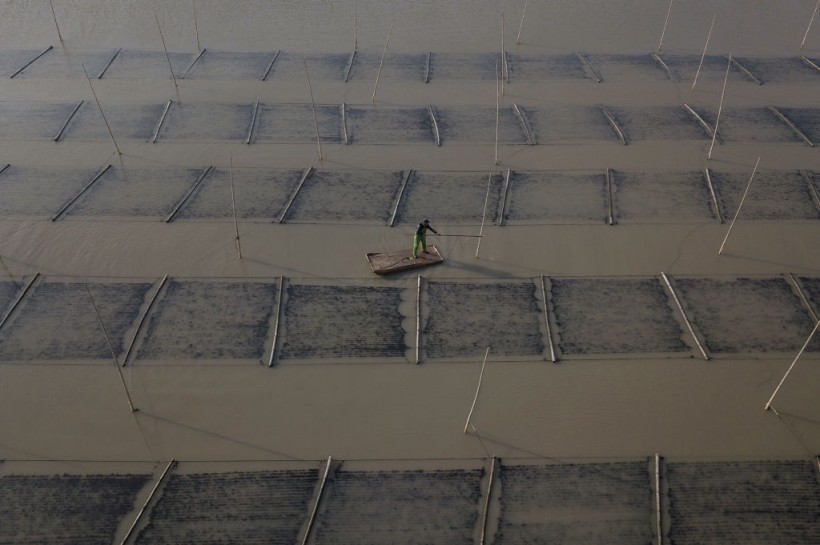A recent study, conducted by an international collaborative team, emphasizes seaweed's potential as a robust food source in the face of sudden sunlight reduction events, such as those seen in scenarios like nuclear winter. The findings reveal that seaweed is surprisingly resilient in adverse conditions, with its growth and ability to enhance food security showing increased potential following more severe nuclear conflicts.

This aerial photo taken on December 12, 2019 shows a man (C) working at a floating seaweed farm in Xiapu in China's Fujian province.
Seaweed: A Sunlit Solution for Global Food Security
In the hypothetical scenario of a nuclear war involving extensive warhead exchanges, around 150 Teragram (Tg) of soot emissions could be released, leading to prolonged sunlight blockage. Despite this, the researchers found that there would be enough sunlight for seaweed to undergo photosynthesis and flourish, even in the presence of black carbon in the atmosphere.
Professor Michael Roleda, a study co-author, emphasized that certain seaweed species require minimal light, as low as 50-100 µmol photons, for photosynthesis saturation, while the tropics receive nearly 2,000 µmol photons during a cloudless day noon.
The study proposes that with optimal cultivation and preparation areas, seaweed could potentially fulfill 45% of global food demand within nine months of intensified production. However, the researchers caution that seaweed's high iodine content limits its contribution to only 15% of the human diet.
Beyond the context of an all-out nuclear war, the researchers suggest seaweed as a viable enhancement to global food security in various scenarios, including smaller nuclear conflicts and volcanic eruptions.
READ ALSO: Seaweed-Eating Crabs Could Help Save Threatened Coral Reefs
How Can Seaweed Solve Famine During a Nuclear War
Seaweed, a nutrient-rich resource, sustains livelihoods in coastal communities, particularly in lower-income countries. David Denkenberger, a mechanical engineering associate professor at the University of Canterbury, suggests investing in seaweed farms as a preventive measure against global famine in scenarios of abrupt sunlight reduction, potentially averting numerous starvation-related deaths.
The study, titled "Seaweed as a Resilient Food Solution After a Nuclear War" published in the journal Earth's Future, underscores seaweed's versatility as a vital food and fuel source during catastrophic events, with the organism resilient enough to endure and flourish even after a full-scale nuclear war.
The researchers crafted a model based on Gracilaria tikvahiae, commonly known as graceful redweed, simulating seaweed growth after adverse global events using available nuclear winter climate data. Seaweeds, often consumed in salads or as dried food wraps offer richness in proteins, minerals, vitamins, essential amino acids, and fatty acids.
Despite potential post-nuclear war contamination, seaweeds can undergo post-harvest processing and pre-consumption preparation, like washing, drying, enzymatic reactions, blanching, or cooking, to significantly reduce iodine and heavy metal concentrations, making them suitable for human consumption.
In 2021, Asia contributed 97% of the 34.7 million tons of global cultivated seaweed production, as highlighted by a Food and Agriculture Organization report. While China dominates as the world's leading producer, followed by Indonesia, South Korea, and the Philippines, a contrasting study warns of global consequences, including marine life decimation, from nuclear wars.
Regardless of findings, Ravi Rebbapragada, chair of Mines, Minerals & PEOPLE, emphasizes the imperative to avoid nuclear wars due to their inherent danger and long-lasting impact on the global climate.
RELATED ARTICLE: California Startup Uses Seaweed to Replace Packaging, Plastic Bags: How Does It Work?
Check out more news and information on Seaweed in Science Times.




![Earth's Quasi-Moon Kamo‘oalewa Could Originate From Lunar Surface Not Asteroid Belt [Study]](https://1721181113.rsc.cdn77.org/data/thumbs/full/53275/89/56/50/40/earths-quasi-moon-kamo-oalewa-could-originate-from-lunar-surface-not-asteroid-belt-study.png)









